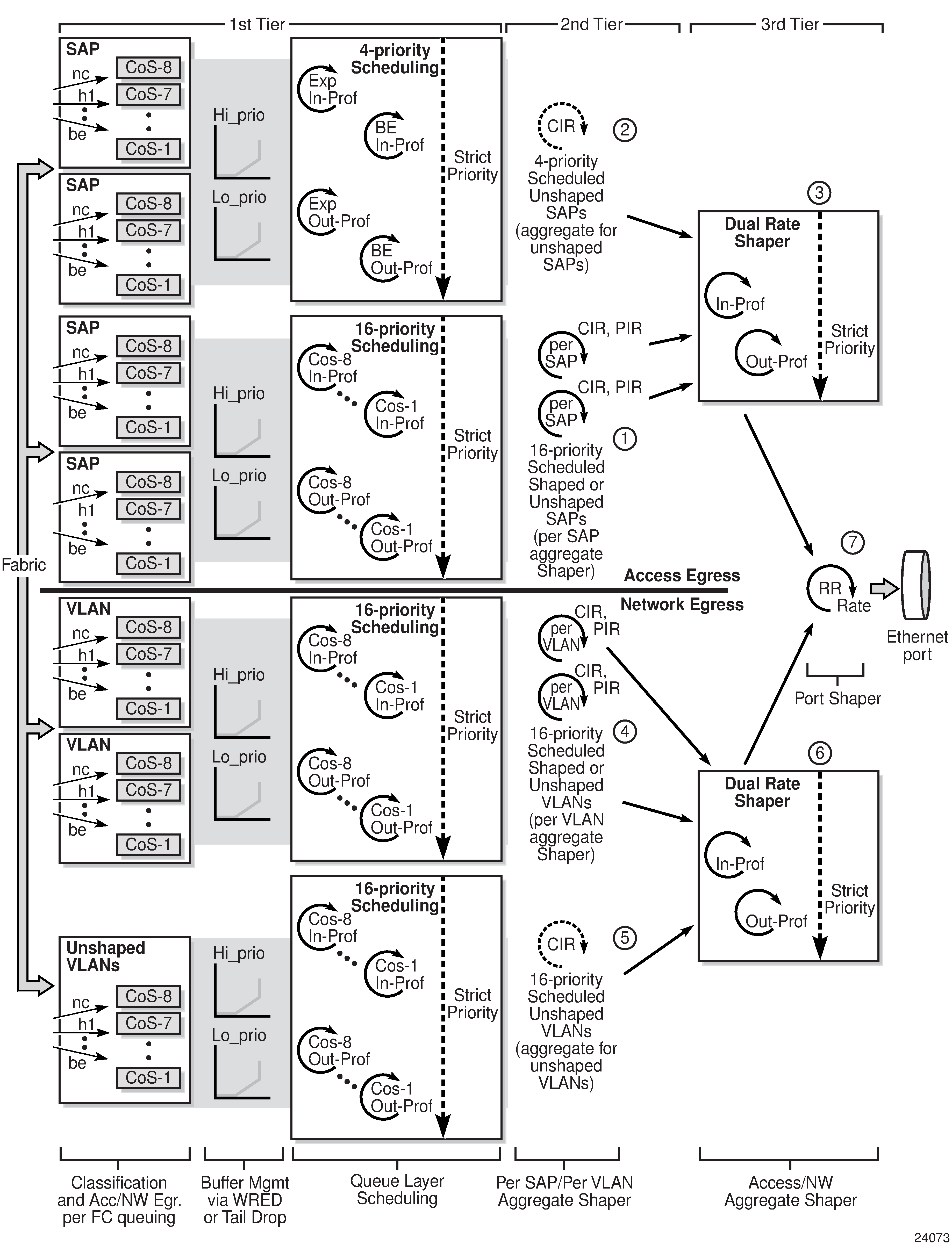This section provides information on QoS for hybrid ports on Gen-2 adapter cards and platforms. For information on Gen-3 adapter cards and platforms, see QoS for Gen-3 Adapter Cards and Platforms.
In the ingress direction of a hybrid port, traffic management behavior is the same as it is for access and network ports. See Access Ingress and Network Ingress.
In the egress direction of a hybrid port, access and network aggregate shapers are used to arbitrate between the bulk (aggregate) of access and network traffic flows. As shown in Figure: Hybrid Port Egress Shapers and Schedulers on Gen-2 Hardware, on the access side (above the solid line), both the access egress SAP aggregates (#1) and the unshaped SAP shaper (#2) feed into the access egress aggregate shaper (#3). On the network side (below the solid line), both the per-VLAN shapers (#4) and the unshaped interface shaper (#5) feed into the network egress aggregate shaper (#6). Then, the access and the network aggregate shapers are arbitrated in a dual-rate manner, in accordance with their respective configured committed and peak rates (#7). As a last step, the egress-rate for the port (when configured) applies backpressure to both the access and the network aggregate shapers, which apply backpressure all the way to the FC queues belonging to both access and network traffic.
Due to space limitations in Figure: Hybrid Port Egress Shapers and Schedulers on Gen-2 Hardware, the second-tier, per-SAP and per-VLAN aggregate shapers are represented as a single loop containing the label ‟per SAP” or ‟per VLAN”, even though they are dual-rate shapers similar to the third-tier network aggregate shaper. Tiers are labeled at the top of the figure.
As part of the hybrid port traffic management solution, access and network second-tier shapers are bound to access and network aggregate shapers, respectively. The hybrid port egress datapath can be visualized as access and network datapaths that coexist separately up until the access and network aggregate shapers at Tier 3 (#3 and #6).
In Figure: Hybrid Port Egress Shapers and Schedulers on Gen-2 Hardware, the top half is identical to access egress traffic management, where CoS queues (Tier 1) feed into either per-SAP shapers for shaped SAPs (#1) or a single second-tier shaper for all unshaped SAPs (#2). Up to the end of the second-tier, per-SAP aggregate shapers, the access egress datapath is maintained in the same manner as an Ethernet port in access mode. The same logic applies for network egress. The bottom half of the figure shows the datapath from the CoS queues to the per-VLAN shapers, which is identical to the datapath for any other Ethernet port in network mode.
The main difference between hybrid mode and access and network modes is shown when the access and the network traffic is arbitrated towards the port (Tier 3). At this point, a new set of dual-rate shapers (called shaper groups) are introduced: one shaper for the aggregate (bulk) of the access traffic (#3) and another shaper for the aggregate of the network traffic (#6) —to ensure rate-based arbitration among access and network traffic.
Depending on the use and the application, the committed rate for any one mode of flow might need to be fine-tuned to minimize delay, jitter and loss. In addition, through the use of egress-rate limiting, a fourth level of shaping can be achieved.
When egress-rate is configured (under config>port>ethernet), the following events occur:
egress-rate applies backpressure to the access and network aggregate shapers
as a result, the aggregate shapers apply backpressure to the per-SAP and per-VLAN aggregate shapers
access aggregate shapers apply backpressure to the per-SAP aggregate shapers and the unshaped SAP aggregate shaper
network aggregate shapers apply backpressure to the per-VLAN aggregate shapers and the unshaped VLAN aggregate shaper
as a result, the per-SAP and per-VLAN aggregate shapers apply backpressure to their respective CoS queues
